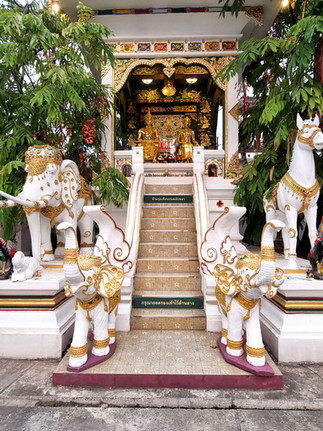Wat MingMuang - The Temple of Crouching Elephants
- Shannon
- Oct 4
- 4 min read
Chiang Rai’s Royal Sanctuary
In ancient times, this area was a fertile swampland, rich in natural resources and home to a thriving population of wild elephants. These gentle giants, long regarded as sacred beings and powerful symbols of royalty throughout Southeast Asia, roamed freely across the land, their presence deeply influencing the spiritual and cultural identity of the region. Nearly 800 years ago, Aua Ming Chom Mueang, a Queen from Southern China, arrived and chose this very site to establish her personal temple grounds. Captivated by the area's natural beauty and the profound spiritual energy she believed emanated from the elephants, she founded a temple in their honour. She named it Wat Chang Moop or the Temple of Crouching Elephants, a title that reflected not only the physical presence of the elephants but also their symbolic significance. The temple became a place of quiet devotion and royal reverence, a sanctuary where nature and the sacred intertwined, leaving behind a lasting legacy that still echoes through the landscape today.

During the late 13th century, one of King Mengrai’s wives ordered the first known restoration of the temple complex, dedicating the effort as a tribute to her mother in law, Queen Thop. This act of reverence honored the Queen’s legacy not only as a royal matriarch but also as the original visionary behind the temple’s creation. After Queen Thop’s passing, the temple took on even greater personal significance for King Mengrai, who was known to visit regularly to pay respects. Her ashes were interred within the ancient pagoda on the grounds, transforming the site into a royal memorial and a place of quiet devotion, where the presence of the Queen Mother continued to be honoured through ritual and remembrance.
The last remaining wooden viharn (on the left hand side) was built in 1262
Many centuries later, in the 1600's, the Lanna Kingdom fell into turmoil as the Burmese Mon dynasty launched a sweeping invasion across the region. Their forces descended upon the north, eventually conquering key cities, including Chiang Rai. The once independent Lanna Kingdom was brought under Burmese control and with the occupation came waves of cultural, political and spiritual change. Though the conquest was marked by bloodshed, displacement and the subjugation of local rulers. It also ushered in a period of architectural transformation. The Burmese brought with them the ornate and deeply symbolic Shan style, which began to dominate temple construction throughout the region. While many feared the loss of Lanna identity, the invaders, recognising the spiritual power and cultural importance of sacred sites, chose not to destroy them but to preserve and reshape them in their own image.
The temple complex, already steeped in centuries of royal lineage and reverence, underwent another major phase of restoration and expansion under Shan influence. Intricately carved teak details, tiered roofs and gilded stupas were introduced, blending with the existing Lanna elements to create a hybrid architectural legacy. Though born from conquest, this era of transformation ensured the survival of the temple and infused it with new layers of meaning, bearing witness to both the resilience of the sacred and the scars of history.

This image of Buddha is over 400 years old and is called Luang Phor Phra Sri Ming Muang
In 1970, the temple was officially enlisted as a recognised Buddhist temple of Thailand and was renamed Wat Ming Muang, meaning The Auspicious Temple of the City. This marked a significant moment in its long and layered history, as it was formally brought under the care and acknowledgment of the Thai Sangha. That same year, it was granted Wisung Khama Sima or a royal decree that officially designates temple boundaries, allowing ordained monks to conduct sacred rites and ceremonies in accordance with Theravāda Buddhist tradition. This designation not only affirmed the temple’s spiritual importance but also safeguarded its religious function under Thai law. Today, Wat Ming Muang remains a fully active community temple, hosting daily rituals, festivals and monastic practices. It continues to be a revered place of worship for locals and pilgrims alike, as a living testament to centuries of devotion, resilience and transformation.

Elephants adorn this temple, in homage to the temples original name and the traditional owners of the ancient land
🗺️ Location
Trairat Road, Tambon Wiang, Mueang, Chiang Rai District, Thailand
🚆 How to get there
Wat MingMuang is nestled in the heart of Chiang Rai’s old town, just a fiveminute walk from the city’s central hub. Despite its central location, the temple retains a serene atmosphere, surrounded by quiet streets and local residences. The temple complex is compact yet historically rich, featuring ancient pagodas, traditional Lanna-style architecture, and carefully preserved shrines. Its proximity to the city centre, less than 1 kilometre from the main markets and civic areas, makes it easily accessible for visitors while still offering a peaceful retreat from the bustle.
⭐ Attraction Info
Wat MingMuang - The Temple of Crouching Elephants is open between 8am - 4:30pm daily and is free to enter, although small donations towards the temples upkeep would be greatly appreciated. It will take about 20 minutes to wander through and photograph. Given the age and history of this ornate temple, I would make the effort to see it if you're on this side of town, as not many tourists seem to bother.


















